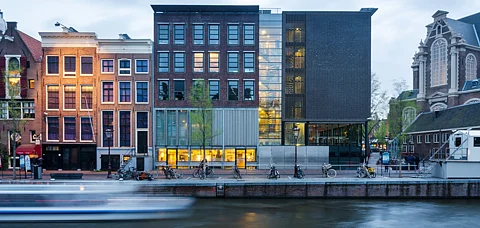
- Destinations
- Experiences
- Stay
- What's new
- Editor’s Picks
- Responsible Tourism
- CampaignsCampaigns
- Subscribe

On June 12 1942, Anne Frank's thirteenth birthday, her father gifted her a diary. Not even a month after, Anne Frank and her family had to go into hiding to escape persecution by the Nazi government. The diary became a space for personal musings of a girl growing up amid a war, in hiding, trying to understand herself and the world around her.
In 1957, 12 years after the unfortunate death of Anne and most of her family, in collaboration with Otto Frank, Anne's father, a non-profit organization turned and took the responsibility of maintaining the secret annexe and the place they hid in into a museum. And that is how Anne Frank House came to be. The biographical museum is now one of the must-visit places in Amsterdam, giving a closer look into the struggles and trauma many people went through during the war.
The Museum Tour
The Anne Frank House is dedicated to preserving the hiding place where Anne Frank and her family lived during World War II. Anne Frank was a Jewish girl who gained worldwide fame posthumously with the publication of her diary, "The Diary of a Young Girl," which documented her experiences while in hiding.
The Anne Frank House is situated in the actual building where Anne and her family and four other people hid from the Nazis between 1942 and 1944. The building is known as the "Achterhuis" (Secret Annex) and is located behind a concealed bookcase in Anne's father's office.
In the museum, visitors can immerse themselves in the story through pictures, personal objects, and quotes. The building has two main parts&ndashthe main house and the annexe&ndashwhich played a significant role in the lives of the eight individuals who hid there. The main house has been converted into a museum, while the annexe remains empty in compliance with Otto Frank's wishes.
Visitors can see Anne Frank's room at the museum, which retains the original decor. Additionally, a room is dedicated to her diary, which houses the original copy. Anne also had two other notebooks&ndasha "Favorite Quote Book," where she recorded her favourite quotes, and a "Tales Book," where she wrote a few stories of her own.
The hidden bookcase also gives a profound glimpse into her life. The bookcase was an entrance to the secret annexe, and the cupboard was attached to cloak it well. On the walls are marks indicating Margot and Anne's heights. These marks are a reminder of the time they spent hiding and fearing for their lives during their childhood.
While in hiding, the family stayed informed about the events of the war. Otto Frank monitored the movements of the forces by using a map of Normandy, which is now on display at the museum.
You must also visit the shop which houses the book, "Diary Of A Young Girl," made out of Anne's diary entries in many languages, postcards, poster books and other souvenirs.
There are several other curated experiences in the other building, where visitors could watch movies and pictures related to Anne Frank, the hiding place, the family's photo archive, etc. These exhibits change every few months, so it would be a good idea to check the latest details about the exhibits before your visit.
How to Reach
The Anne Frank House is situated at Prinsengracht 263-267 in the heart of Amsterdam. Around the corner, at Westermarkt 20, is where the museum's entrance is located. The distance from Amsterdam Central Station is 20 minutes by foot. Take trams 13 or 17 instead, and get off at the Westermarkt stop.
The entry is only through the tickets bought online for a specific slot, which opens every Tuesday at 10 am for the next six weeks.
Cover photo credit depositphotos.com
